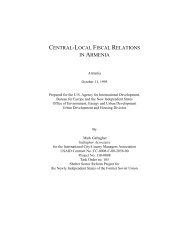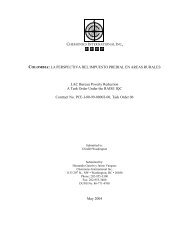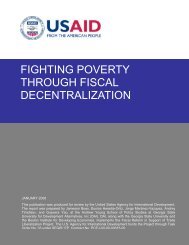Effectiveness and Economic Impact of Tax Incentives in the SADC ...
Effectiveness and Economic Impact of Tax Incentives in the SADC ...
Effectiveness and Economic Impact of Tax Incentives in the SADC ...
Create successful ePaper yourself
Turn your PDF publications into a flip-book with our unique Google optimized e-Paper software.
3-6 EFFECTIVENESS AND IMPACT OF TAX INCENTIVES IN THE <strong>SADC</strong> REGION<br />
•<br />
•<br />
example <strong>of</strong> redundancy is a resource-based <strong>in</strong>vestment such as diamond m<strong>in</strong><strong>in</strong>g projects <strong>in</strong><br />
Botswana or titanium m<strong>in</strong><strong>in</strong>g projects <strong>in</strong> Mozambique. As long as <strong>the</strong> projects are<br />
fundamentally viable, tax <strong>in</strong>centives are redundant. The <strong>in</strong>vestors cannot simply pull up<br />
stakes <strong>and</strong> shift <strong>the</strong>ir operations to Costa Rica or Bangladesh.<br />
Partial redundancy: In some cases tax <strong>in</strong>centives may be essential to attract a particular<br />
<strong>in</strong>vestment, but <strong>the</strong> benefit package is more generous than necessary. The <strong>in</strong>centive is <strong>the</strong>n<br />
partially redundant, <strong>and</strong> a portion <strong>of</strong> <strong>the</strong> tax break is a genu<strong>in</strong>e revenue loss to <strong>the</strong> treasury. 27<br />
For example, consider a project with a hurdle rate <strong>of</strong> 25 percent <strong>and</strong> a prospective rate <strong>of</strong><br />
return before tax <strong>of</strong> 34 percent. If <strong>the</strong> tax rate is 35 percent, <strong>the</strong>n <strong>the</strong> after-tax rate <strong>of</strong> return is<br />
just 22 percent. Under <strong>the</strong> normal tax system, <strong>the</strong> project will not be implemented.<br />
However, if <strong>the</strong> <strong>in</strong>vestor were <strong>of</strong>fered a 10-year tax holiday that boosts <strong>the</strong> net return to,<br />
say, 30 percent, <strong>the</strong>n <strong>the</strong> project would go ahead. But this tax holiday actually pushes <strong>the</strong><br />
return well above <strong>the</strong> hurdle rate <strong>of</strong> 25 percent. The project would be viable with a tax<br />
break less than half this large. So more than half <strong>of</strong> <strong>the</strong> benefit is redundant.<br />
In real-world situations, governments do not have <strong>in</strong>side <strong>in</strong>formation about <strong>the</strong> <strong>in</strong>vestor’s<br />
hurdle rate or expectation <strong>of</strong> pr<strong>of</strong>itability. So it is very difficult to judge whe<strong>the</strong>r a given<br />
<strong>in</strong>centive is essential, redundant, or partially redundant. An <strong>in</strong>terest<strong>in</strong>g example arose <strong>in</strong><br />
Mozambique <strong>in</strong> 1997−1998 when <strong>the</strong> government was negotiat<strong>in</strong>g fiscal benefits for <strong>the</strong> $1.3<br />
billion Mozal alum<strong>in</strong>um smelter project. There is widespread agreement that large tax<br />
<strong>in</strong>centives were essential for l<strong>and</strong><strong>in</strong>g this huge strategic project. Yet <strong>the</strong>re has also been<br />
much debate about whe<strong>the</strong>r <strong>the</strong> deal was too generous. Mozambique did not <strong>of</strong>fer a zero<br />
tax rate. Ra<strong>the</strong>r, Mozal was subject to a 1 percent tax on gross export revenue. 28 If a zero<br />
rate was not needed for Mozal, <strong>the</strong>n it is not needed for most o<strong>the</strong>r <strong>in</strong>vestments. As a rule, a<br />
zero tax rate entails an unnecessary loss <strong>of</strong> revenue.<br />
“Reverse foreign aid”: This case arises when <strong>the</strong> <strong>in</strong>vestor orig<strong>in</strong>ates from a country such as<br />
<strong>the</strong> United States, Japan, or <strong>the</strong> United K<strong>in</strong>gdom, which taxes worldwide <strong>in</strong>come upon<br />
repatriation, subject to a tax credit for <strong>the</strong> imputed tax obligation to <strong>the</strong> host country. Under<br />
<strong>the</strong>se conditions a tax break <strong>in</strong> <strong>the</strong> host country—or a tax rate below that <strong>in</strong> <strong>the</strong> <strong>in</strong>vestor’s<br />
home country—is simply <strong>of</strong>fset by additional tax payable <strong>in</strong> <strong>the</strong> source country. The tax<br />
<strong>in</strong>centive may have no effect on <strong>the</strong> <strong>in</strong>vestment decision. This situation is called “reverse<br />
foreign aid” because <strong>the</strong> host-country treasury is effectively giv<strong>in</strong>g money away to <strong>the</strong><br />
source-country treasury.<br />
27 The impact <strong>of</strong> a tax <strong>in</strong>centive <strong>of</strong>fered by <strong>the</strong> host country also depends on whe<strong>the</strong>r its basic company tax rate<br />
exceeds that <strong>of</strong> <strong>the</strong> source country, <strong>the</strong> technical specification <strong>of</strong> <strong>the</strong> tax <strong>in</strong>centive, whe<strong>the</strong>r <strong>the</strong> company has<br />
excess foreign tax credits on its worldwide <strong>in</strong>come, <strong>and</strong> source country provisions for Controlled Foreign<br />
Corporation treatment <strong>of</strong> earn<strong>in</strong>gs reta<strong>in</strong>ed <strong>of</strong>fshore. See Slemrod (1995) for a careful explanation <strong>of</strong> <strong>the</strong> hosthome<br />
country tax l<strong>in</strong>kage.<br />
28 This device not recommended for general application because <strong>the</strong> effective tax rate varies unpredictably<br />
from year to year <strong>and</strong> from company to company depend<strong>in</strong>g on <strong>the</strong> pr<strong>of</strong>it marg<strong>in</strong>. If pr<strong>of</strong>its are 20 percent <strong>of</strong><br />
sales, a 1 percent turnover tax is equivalent to a 5 percent tax on pr<strong>of</strong>it. If pr<strong>of</strong>its are higher <strong>the</strong> effective tax<br />
rate is lower, <strong>and</strong> vice versa. This is not a sensible system.











